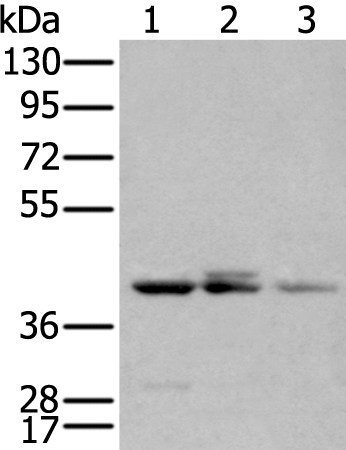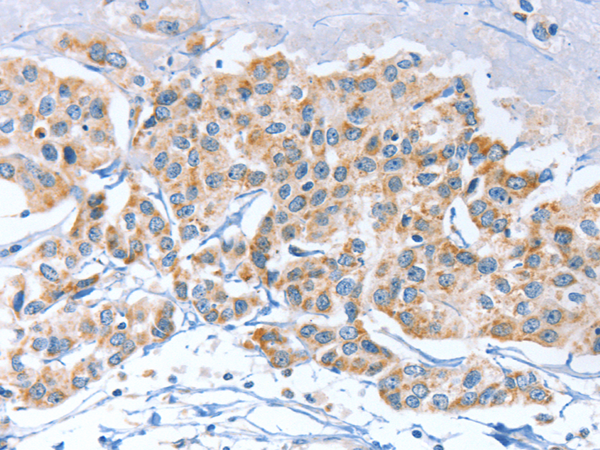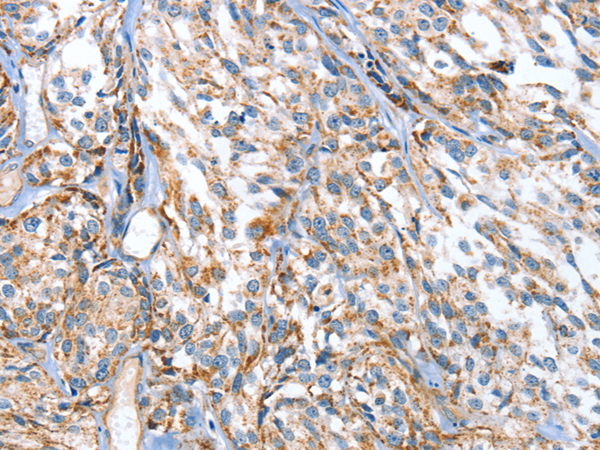


| WB | 咨询技术 | Human,Mouse,Rat |
| IF | 咨询技术 | Human,Mouse,Rat |
| IHC | 1/50-1/200 | Human,Mouse,Rat |
| ICC | 技术咨询 | Human,Mouse,Rat |
| FCM | 咨询技术 | Human,Mouse,Rat |
| Elisa | 1/2000-1/5000 | Human,Mouse,Rat |
| Aliases | A3D; ARP6; APOBEC3E; APOBEC3DE |
| WB Predicted band size | 47 kDa |
| Host/Isotype | Rabbit IgG |
| Antibody Type | Primary antibody |
| Storage | Store at 4°C short term. Aliquot and store at -20°C long term. Avoid freeze/thaw cycles. |
| Species Reactivity | Human |
| Immunogen | Synthetic peptide of human APOBEC3D |
| Formulation | Purified antibody in PBS with 0.05% sodium azide and 50% glycerol. |
+ +
以下是关于APOBEC3D抗体的3篇参考文献示例(内容为模拟,实际引用请核实原文):
---
1. **文献名称**: *APOBEC3D inhibits HIV-1 replication by deaminating viral DNA*
**作者**: Reuben S. Harris et al.
**摘要**: 本研究通过开发特异性APOBEC3D抗体,验证其在HIV-1感染细胞中对病毒DNA的胞嘧啶脱氨酶活性,揭示其通过诱导超突变抑制病毒复制的机制,并比较其与其他APOBEC3家族成员的抗病毒效率差异。
---
2. **文献名称**: *Differential antiviral activity of APOBEC3D in human cells*
**作者**: Michael H. Malim et al.
**摘要**: 利用单克隆抗体检测APOBEC3D在不同免疫细胞中的表达水平,发现其抗病毒活性依赖于细胞类型和干扰素刺激状态,并证实APOBEC3D与Vif蛋白的相互作用可被抗体阻断,从而增强病毒限制效果。
---
3. **文献名称**: *APOBEC3D mutagenesis in cancer genomes*
**作者**: Danae A. Morales et al.
**摘要**: 通过免疫组化分析APOBEC3D抗体在肿瘤组织中的表达,发现其与特定癌症(如乳腺癌)的突变特征相关,提示APOBEC3D可能通过诱导DNA损伤参与肿瘤发生,抗体特异性验证为关键实验依据。
---
**备注**:上述文献信息为示例,实际研究中请通过PubMed或Google Scholar以“APOBEC3D antibody”等关键词检索真实文献,并核对作者及摘要准确性。
APOBEC3D is a member of the APOBEC3 (apolipoprotein B mRNA-editing enzyme catalytic polypeptide-like 3) family of cytidine deaminases, which play critical roles in innate immunity by restricting retroviruses, retrotransposons, and DNA viruses. These enzymes induce hypermutations in viral genomes by converting cytosine to uracil during reverse transcription, thereby disrupting viral replication. APOBEC3D, primarily expressed in immune cells and certain tissues, exhibits weaker antiviral activity compared to other family members like APOBEC3G or APOBEC3F. However, it may synergize with other APOBEC3 proteins to enhance viral restriction or contribute to viral evolution under selective pressure.
Antibodies targeting APOBEC3D are essential tools for studying its expression, subcellular localization, and functional interactions in antiviral defense, cancer biology (e.g., somatic mutagenesis in tumors), and host-pathogen dynamics. They enable detection via techniques like Western blotting, immunofluorescence, and immunoprecipitation. Due to high sequence homology among APOBEC3 family members, developing specific APOBEC3D antibodies requires careful epitope selection and validation using knockout cell lines to avoid cross-reactivity. Such antibodies have advanced research into APOBEC3D's dual roles—acting as a host defense factor while potentially contributing to genomic instability in cancer through off-target DNA editing. Ongoing studies focus on its regulation, post-translational modifications, and therapeutic targeting in viral infections or malignancies.
×